The Book Binding Machines Market is estimated to be valued at USD 1.6 billion in 2025 and is projected to reach USD 3.0 billion by 2035, registering a compound annual growth rate (CAGR) of 6.5% over the forecast period.
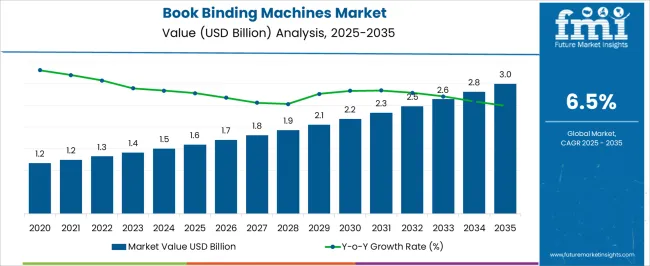
| Metric | Value |
|---|---|
| Book Binding Machines Market Estimated Value in (2025 E) | USD 1.6 billion |
| Book Binding Machines Market Forecast Value in (2035 F) | USD 3.0 billion |
| Forecast CAGR (2025 to 2035) | 6.5% |
The Book Binding Machines market is experiencing steady growth, driven by increasing demand from commercial printing, educational institutions, and office environments. The current market is shaped by a growing need for efficient, high-quality binding solutions that can handle diverse volumes and formats. The adoption of automation in print finishing, coupled with the ongoing trend toward customized publishing, is influencing market expansion.
Investments in infrastructure upgrades and the proliferation of print-on-demand services are further supporting the growth trajectory. The market is also benefitting from the emphasis on cost-effective operations, where reliable machines reduce downtime and improve throughput.
Increasing awareness of high-quality presentation materials in corporate, academic, and commercial sectors is creating additional demand As businesses and educational institutions continue to modernize their document management processes, Book Binding Machines are anticipated to remain essential, with opportunities for growth in both manual and semi-automated operations, ensuring long-term market sustainability and innovation adoption.
The book binding machines market is segmented by machine type, operation type, end use, and geographic regions. By machine type, book binding machines market is divided into Comb Binding Machine, Coil Binding Machine, Wire Binding Machine, Thermal Binding, Strip Binding Machines, Saddle Stitching, Velobind Binding, and Tape Machines. In terms of operation type, book binding machines market is classified into Manual, Electric, and Combo (Manual & Electric). Based on end use, book binding machines market is segmented into Commercial, Personal, and Educational. Regionally, the book binding machines industry is classified into North America, Latin America, Western Europe, Eastern Europe, Balkan & Baltic Countries, Russia & Belarus, Central Asia, East Asia, South Asia & Pacific, and the Middle East & Africa.
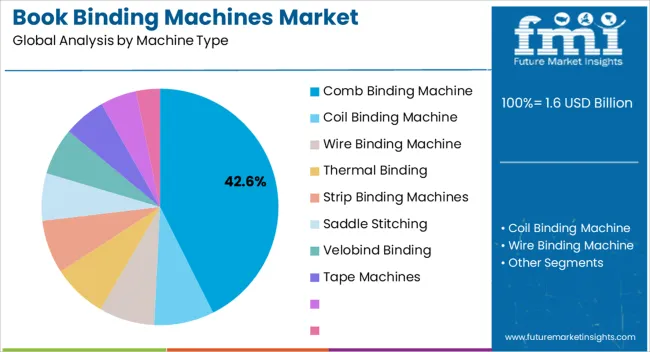
The Comb Binding Machine segment is projected to hold 42.60% of the Book Binding Machines market revenue in 2025, making it the leading machine type. This prominence has been driven by its versatility and ease of use for binding a wide range of document sizes and formats. Adoption has been facilitated by its suitability for commercial offices, educational institutions, and service bureaus that require quick and reliable binding solutions.
The cost-effectiveness and minimal maintenance requirements of comb binding machines have reinforced their widespread utilization. Moreover, the ability to produce durable yet flexible bound documents that can be easily updated or edited has increased their preference over other machine types.
The segment’s growth is further strengthened by the compatibility of comb machines with various cover materials and paper thicknesses, allowing customization without significant operational adjustments Overall, the scalability, reliability, and affordability of comb binding machines have positioned this segment as the dominant contributor to market revenue.
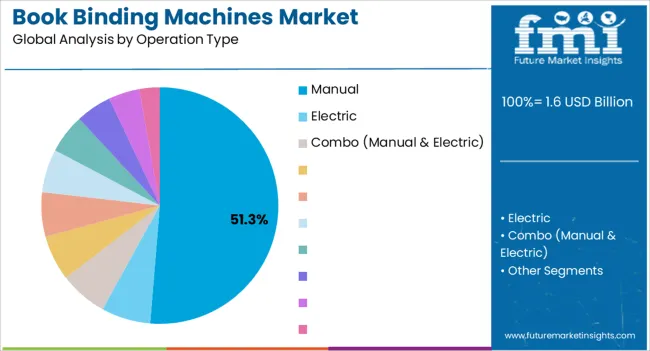
The Manual operation segment is anticipated to capture 51.30% of the overall Book Binding Machines market in 2025, reflecting its continued relevance in commercial and small-scale binding environments. This dominance is attributed to the simplicity and low initial investment of manual machines, which makes them accessible to small businesses, educational institutions, and print service providers.
Manual operations allow precise control over the binding process, reducing the risk of errors in document alignment and punch precision. The ease of handling, portability, and reduced energy requirements further support adoption in offices where binding volumes are moderate.
Additionally, manual machines provide flexibility in producing small batches or customized binding jobs without requiring technical expertise or complex maintenance The affordability and consistent performance of manual operations have reinforced their market position, making them a preferred choice for organizations seeking reliable and cost-effective binding solutions with limited operational complexity.
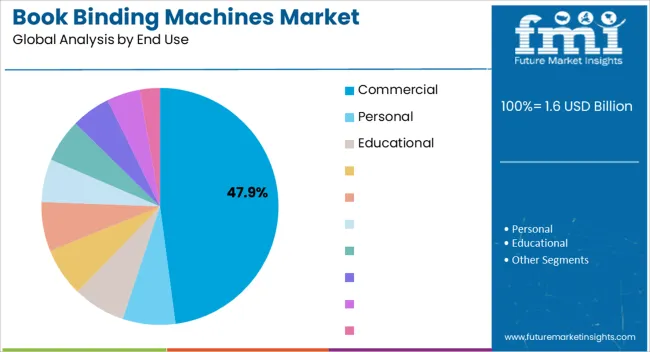
The Commercial end-use industry is projected to account for 47.90% of the Book Binding Machines market revenue in 2025, establishing it as the largest end-user segment. This growth is driven by the increasing need for professionally bound documents, reports, and presentation materials across corporate offices, publishing houses, and service bureaus.
Commercial buyers are prioritizing efficiency, reliability, and scalability in their binding operations, leading to the adoption of machines that can handle varied document sizes and volumes. The demand for durable, customizable, and high-quality bound documents has encouraged investments in machines that allow frequent updates and modifications without compromising output quality.
Furthermore, the integration of binding machines into broader office workflows has improved productivity and reduced operational downtime With businesses emphasizing professional presentation standards and internal document management, the commercial segment continues to drive revenue growth, supporting ongoing innovation and technology adoption in the Book Binding Machines market.
Book binding machines are used in the physically assembling the stack of papers and sheets in the ordered book format. The stack of papers are bound together at one end.
Book binding machines are available in different types for different types of binding. The type of binding preferred decides the type of binding machine to be used. The book binding machines can be operated manually or can be electrically operated.
Commercially book binding machines are finding its applications in libraries for binding of old books, in publication houses and printing press where mainly the books are produced.
Book binding machines can also be used in the offices where certain work has to be documented in the form of hard copy. Book binding machines also find their application in the educational field mainly documenting the important work such as projects, thesis etc. in the hard copy format.
In certain cases book binding machines can be used for personal purpose. The type of book binding machine is selected on the basis of the amount of pages to be bound, type of pages, suitable or required binding type.
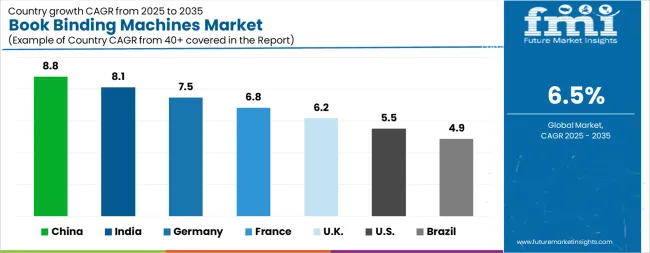
| Country | CAGR |
|---|---|
| China | 8.8% |
| India | 8.1% |
| Germany | 7.5% |
| France | 6.8% |
| UK | 6.2% |
| USA | 5.5% |
| Brazil | 4.9% |
The Book Binding Machines Market is expected to register a CAGR of 6.5% during the forecast period, exhibiting varied country level momentum. China leads with the highest CAGR of 8.8%, followed by India at 8.1%. Developed markets such as Germany, France, and the UK continue to expand steadily, while the USA is likely to grow at consistent rates. Brazil posts the lowest CAGR at 4.9%, yet still underscores a broadly positive trajectory for the global Book Binding Machines Market. In 2024, Germany held a dominant revenue in the Western Europe market and is expected to grow with a CAGR of 7.5%. The USA Book Binding Machines Market is estimated to be valued at USD 595.9 million in 2025 and is anticipated to reach a valuation of USD 1.0 billion by 2035. Sales are projected to rise at a CAGR of 5.5% over the forecast period between 2025 and 2035. While Japan and South Korea markets are estimated to be valued at USD 80.4 million and USD 54.6 million respectively in 2025.
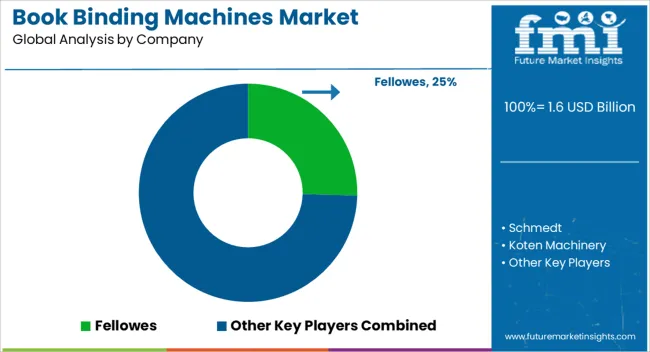
| Item | Value |
|---|---|
| Quantitative Units | USD 1.6 Billion |
| Machine Type | Comb Binding Machine, Coil Binding Machine, Wire Binding Machine, Thermal Binding, Strip Binding Machines, Saddle Stitching, Velobind Binding, and Tape Machines |
| Operation Type | Manual, Electric, and Combo (Manual & Electric) |
| End Use | Commercial, Personal, and Educational |
| Regions Covered | North America, Europe, Asia-Pacific, Latin America, Middle East & Africa |
| Country Covered | United States, Canada, Germany, France, United Kingdom, China, Japan, India, Brazil, South Africa |
| Key Companies Profiled | Fellowes, Schmedt, Koten Machinery, Nichiban, Zechini, Sunfung Technology, Spiral Binding, Iml Machinery, and Duplo International |
The global book binding machines market is estimated to be valued at USD 1.6 billion in 2025.
The market size for the book binding machines market is projected to reach USD 3.0 billion by 2035.
The book binding machines market is expected to grow at a 6.5% CAGR between 2025 and 2035.
The key product types in book binding machines market are comb binding machine, coil binding machine, wire binding machine, thermal binding, strip binding machines, saddle stitching, velobind binding and tape machines.
In terms of operation type, manual segment to command 51.3% share in the book binding machines market in 2025.






Our Research Products

The "Full Research Suite" delivers actionable market intel, deep dives on markets or technologies, so clients act faster, cut risk, and unlock growth.

The Leaderboard benchmarks and ranks top vendors, classifying them as Established Leaders, Leading Challengers, or Disruptors & Challengers.

Locates where complements amplify value and substitutes erode it, forecasting net impact by horizon

We deliver granular, decision-grade intel: market sizing, 5-year forecasts, pricing, adoption, usage, revenue, and operational KPIs—plus competitor tracking, regulation, and value chains—across 60 countries broadly.

Spot the shifts before they hit your P&L. We track inflection points, adoption curves, pricing moves, and ecosystem plays to show where demand is heading, why it is changing, and what to do next across high-growth markets and disruptive tech

Real-time reads of user behavior. We track shifting priorities, perceptions of today’s and next-gen services, and provider experience, then pace how fast tech moves from trial to adoption, blending buyer, consumer, and channel inputs with social signals (#WhySwitch, #UX).

Partner with our analyst team to build a custom report designed around your business priorities. From analysing market trends to assessing competitors or crafting bespoke datasets, we tailor insights to your needs.
Supplier Intelligence
Discovery & Profiling
Capacity & Footprint
Performance & Risk
Compliance & Governance
Commercial Readiness
Who Supplies Whom
Scorecards & Shortlists
Playbooks & Docs
Category Intelligence
Definition & Scope
Demand & Use Cases
Cost Drivers
Market Structure
Supply Chain Map
Trade & Policy
Operating Norms
Deliverables
Buyer Intelligence
Account Basics
Spend & Scope
Procurement Model
Vendor Requirements
Terms & Policies
Entry Strategy
Pain Points & Triggers
Outputs
Pricing Analysis
Benchmarks
Trends
Should-Cost
Indexation
Landed Cost
Commercial Terms
Deliverables
Brand Analysis
Positioning & Value Prop
Share & Presence
Customer Evidence
Go-to-Market
Digital & Reputation
Compliance & Trust
KPIs & Gaps
Outputs
Full Research Suite comprises of:
Market outlook & trends analysis
Interviews & case studies
Strategic recommendations
Vendor profiles & capabilities analysis
5-year forecasts
8 regions and 60+ country-level data splits
Market segment data splits
12 months of continuous data updates
DELIVERED AS:
PDF EXCEL ONLINE
Booklet Label Market Size and Share Forecast Outlook 2025 to 2035
Book Marketing Software Market Size and Share Forecast Outlook 2025 to 2035
Book Wraps Market Size and Share Forecast Outlook 2025 to 2035
Bookends Market Insights - Trends & Forecast 2025 to 2035
Book Publishers Market Insights - Growth & Demand Forecast 2025 to 2035
Evaluating Booklet Label Market Share & Provider Insights
Industry Share & Competitive Positioning in Book Wraps Market
North America Booklet Label Market Growth – Trends & Forecast 2023-2033
Digital Publishing Revolution – Future of eBook Market Trends
Pre-book Airport Transfer Market Size and Share Forecast Outlook 2025 to 2035
Notebook Market Insights – Demand & Growth 2024-2034
Lathe Machines Market
Sorter Machines Market Size and Share Forecast Outlook 2025 to 2035
Europe Booklet Label Market Segmentation by Material Type, Label Type, Printing Technology, End-Use and Region: A Forecast for 2025 and 2035
Virtual Machines Market by Type, by Enterprise Size, by Industry & Region Forecast till 2035
Bandsaw Machines Market Growth - Trends & Forecast 2025 to 2035
Market Share Insights of Leading Protein Binding Assays Providers
Wrapping Machines for Handkerchiefs Market Size and Share Forecast Outlook 2025 to 2035
Sleeving Machines Market Size and Share Forecast Outlook 2025 to 2035
Drilling Machines Market Size and Share Forecast Outlook 2025 to 2035

Thank you!
You will receive an email from our Business Development Manager. Please be sure to check your SPAM/JUNK folder too.
Chat With
MaRIA